Chart of the Week: Only 57% of personal emails are now being opened by recipients and just 37% are viewed as being useful
People are now spending less time checking their emails, according to research from Adobe. Personal emails have seen the biggest drop since 2016, in terms of minutes spent checking them, following a small increase in 2018. When it comes to business emails, while they are checked less than in 2016, they have seen an increase in minutes being spent looking at them compared to 2017 and 2018.
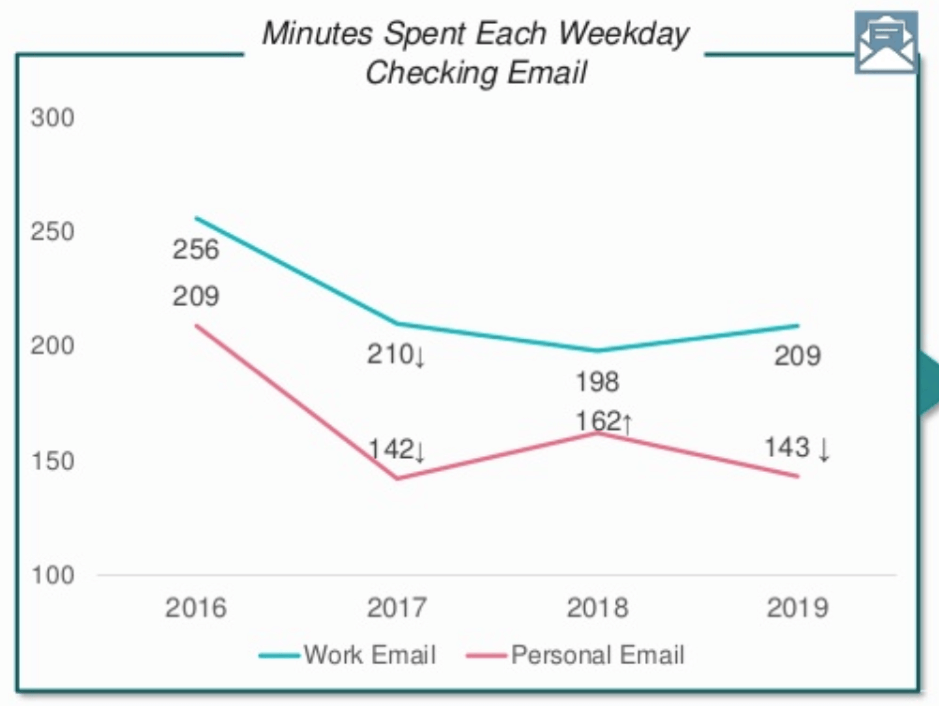
Personal versus work emails
In terms of open rates, people are a lot more likely to open work emails than personal emails. Around 80% of work emails are opened on average, with 59% of work emails being deemed useful by recipients. In fact, people spent three hours or more checking work emails each day, with most individuals checking them frequently outside of work.
When it comes to personal emails, only 57% are opened with just 37% being found useful. They are also checked less often than work emails in general, coming in at just over two hours a day, which is a 143-minute decline across a month compared to 2016.
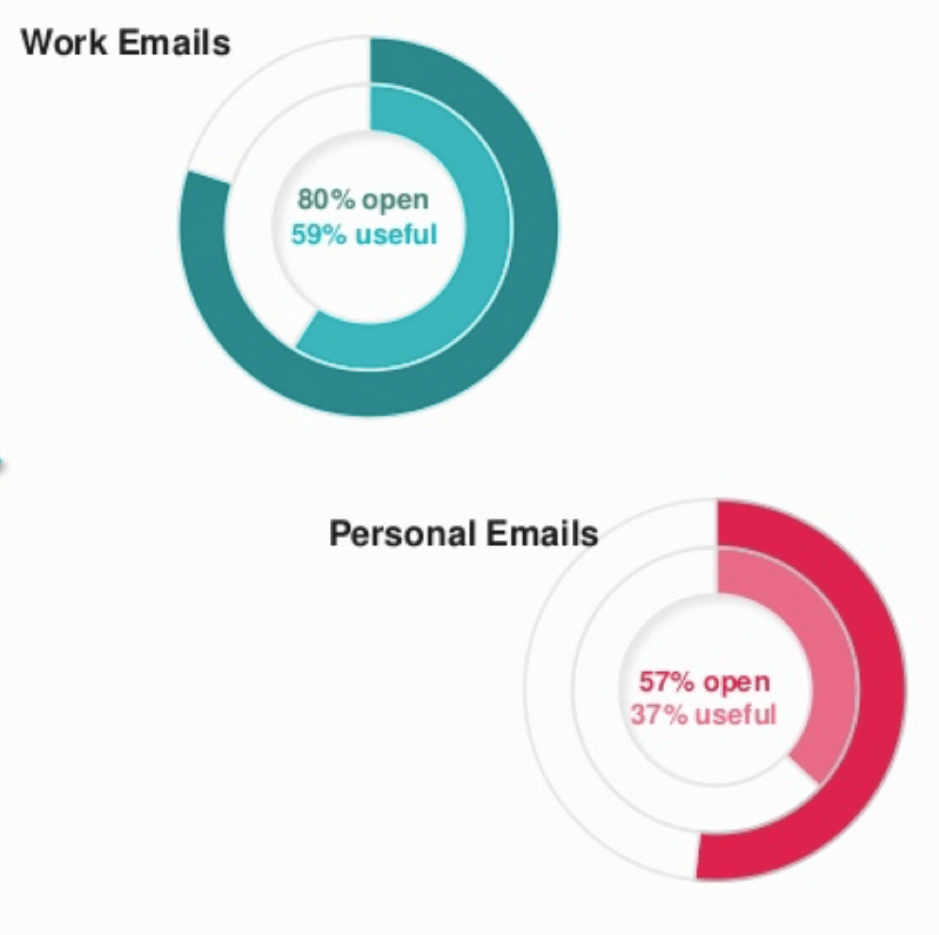
This difference is likely due to the number of newsletters, triggered and sales emails that individuals now receive when they create accounts online. This means that marketers have a bigger fight than ever to get their emails noticed and opened, let alone have them be viewed as helpful.
Although personal emails are checked less often, they are still regularly checked while at work, with 52% of respondents saying they look at their personal email every few days during the workday. Millennials are most likely to check personal emails at work, with 31% saying they do so multiple times an hour while 26% of Gen X say the same.
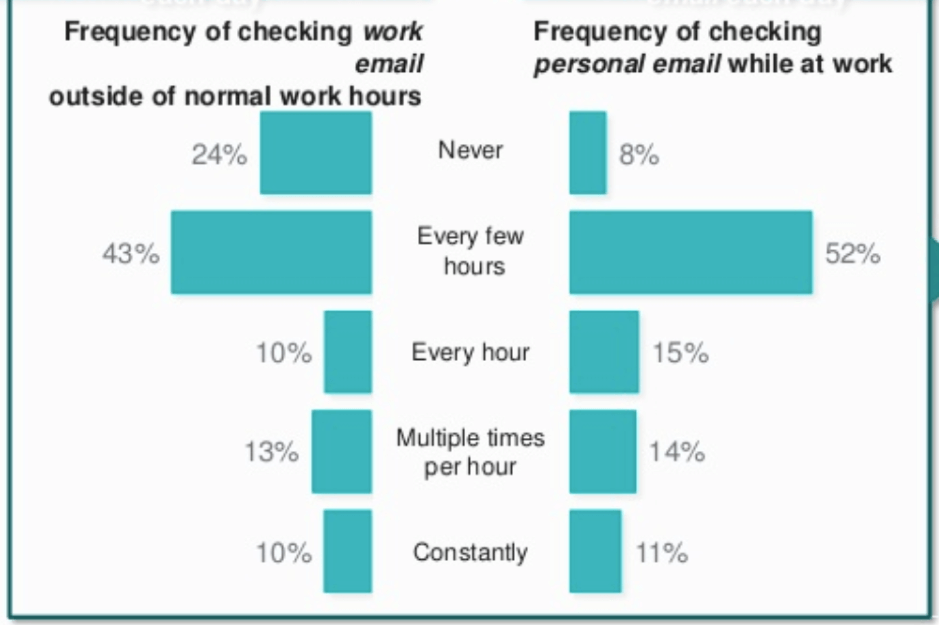
Although the amount of time spent checking emails has declined, the majority of respondents (71%) say that they feel the amount of time they spend checking emails is “just right”, which is unchanged YoY. However, Millennials and Gen X are most likely to say they feel they need to cut back on how often they check their inboxes.
When do people check their emails?
In terms of when people check their emails, there is a fair differentiation between work and personal emails.
As you might expect, 48% of people first check their work emails once they get to work, suggesting a fairly good work/life balance. However, a quarter (25%) of respondents actually check them while they are getting ready for work and 13% check them while they are still in bed.

This is an improvement on previous years though, as fewer people are checking their work emails while in bed and more are checking them once they get to work, although 15% also check them while commuting, which is an increase on last year. It seems that Millennials are driving this change, as they start to match the work email habits of older generations rather than allowing work to take over their personal lives.
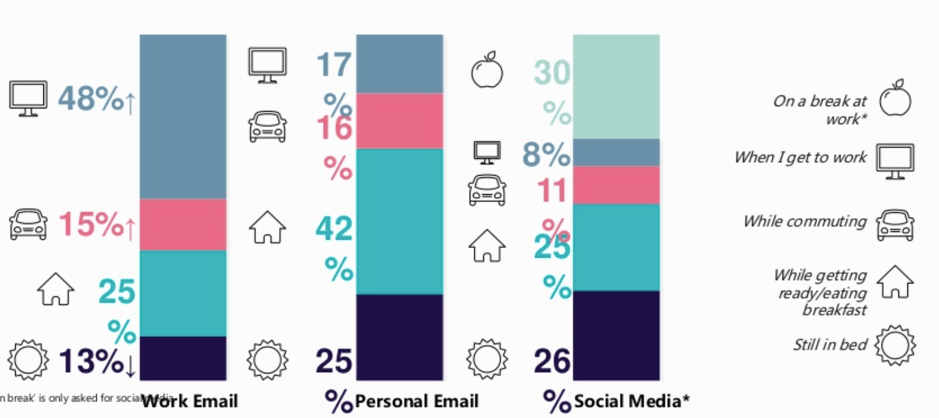
When it comes to personal emails, the majority (42%) of them are checked while people are getting ready for work, although a quarter (25%) of respondents check them before getting out of bed. Just 17% of people look at their personal emails in the office, while 16% check them when commuting.
Generational differences in email habits
The research highlights some other clear differences in terms of when people check their emails and the difference in habits between Millennials, Gen Xers and Baby Boomers.
Although Millennials are adopting habits that mean their work email is not as important during their personal time, they are still much more likely than Baby Boomers to check their work email throughout the day.
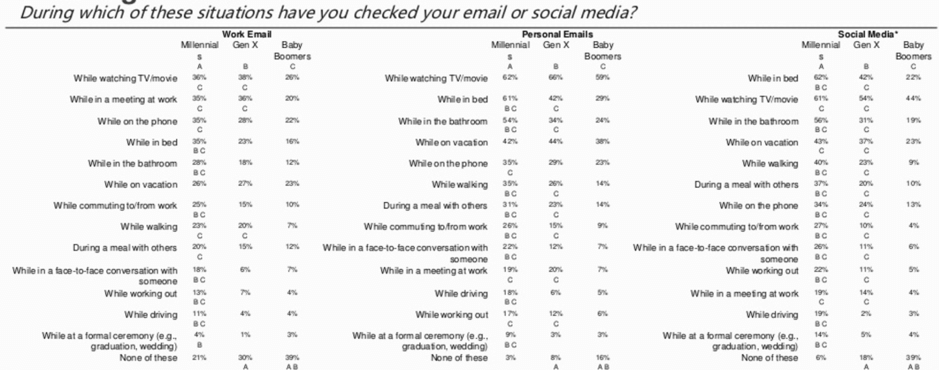
Other than in the office, Millennials are most likely to look at their work emails while watching TV, with 36% of them admitting to this, compared to just 26% of Baby Boomers. They are also much more likely to check them while in a meeting at work (35% versus 20%), while on the phone (35% versus 22%), while in bed (35% versus 16%) and while in the bathroom (28%).
However, Millennials (26%), Gen Xers (27%) and Baby Boomers (23%) are all similarly as likely to check their work emails in while on vacation, suggesting that many people are not able to fully switch off while on holiday.
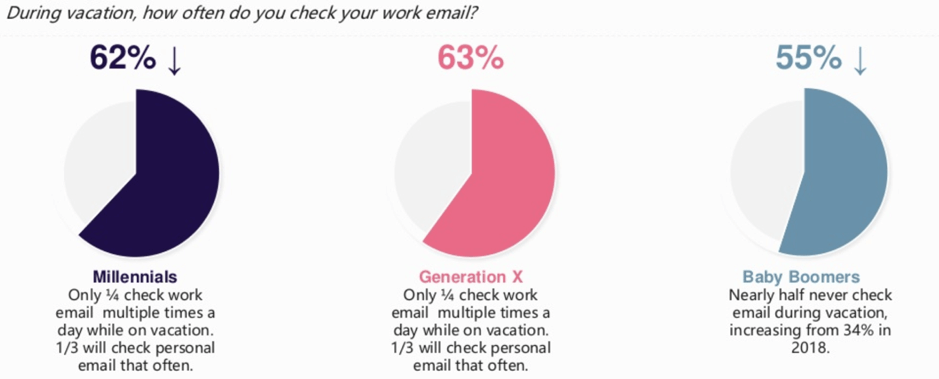
A much higher percentage of Baby Boomers have never checked their work email during any of the situations include in the survey, with 39% saying none of them compared to 21% of Millennials.
In terms of personal emails, they are also most likely to be checked while watching TV with the gap closing across all three generations. Some 62% of Millennials say they do this along with 66% of Gen X and 59% of Baby Boomers.
However, the gap grows from this point, with Millennials once again being much more likely to check their personal emails while performing other tasks. Around 61% said they check emails while in bed compared to 29% of Baby Boomers and over half (54%) say they check them when in the bathroom, which just 24% of Baby Boomers do.
Once again, Baby Boomers are less likely to check personal emails during the times included in the survey, with 16% saying they don’t check their emails during any of these situations, compared to 3% of Millennials and 8% of Gen Xers. This difference suggests that the use of smart devices means that Millennials are used to being a lot more connected than older generations, which makes them more likely to check emails.
Inbox zero
Inbox zero is when people aim to keep their inbox at zero - or as close to it as possible - by reading and sorting their emails on a regular basis. The number of people achieving inbox zero has seen a decline, with just 46% achieving it compared to 55% in 2018.
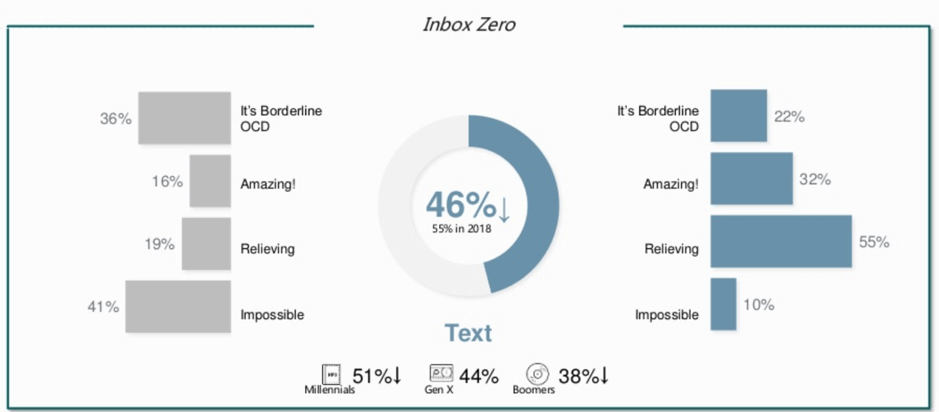
Of those who do manage to keep their inbox at zero, over half (55%) say that doing so is relieving and 32% say that it is amazing to be able to do so. In comparison, 41% of those who don’t currently work to an inbox zero method say that it is impossible to keep your inbox empty. A further 36% say that this approach is borderline OCD.
It is likely to be harder than ever before to maintain an inbox zero approach to emails as the number of emails received on a daily basis s increasing. Even with increased connectivity, sorting through emails today is likely to take more time and as we know from the report, people are spending less time reading emails than before.
Most annoying problems with emails
The research reveals that only a quarter, on average across personal and work emails, of email offers sent from brands are interesting enough for recipients to read. The main reasons recipients don’t read offer emails are related to the frequency of emails and their quality.
Some 38% of recipients say that being emailed too often is the biggest issue when it comes to offers sent to their work email, with 43% saying this is the main problem with personal email offers. This is obviously an issue that email marketers need to address in both B2B and B2C settings.
For work email, the second most annoying issue is that the marketer’s data about the recipient is wrong, which was cited by 25% of respondents. This obviously means that the email is not relevant or as targeted as intended. However, the incorrect information may be due to the recipient providing the wrong information upon signup.
When it comes to personal emails, just under a quarter (24%) say emails that are urging them to buy something they have already purchased is an annoying part of email offers, putting this reason in second place. This is obviously a targeting fault and could be due to email marketers not looking at customer data fully.
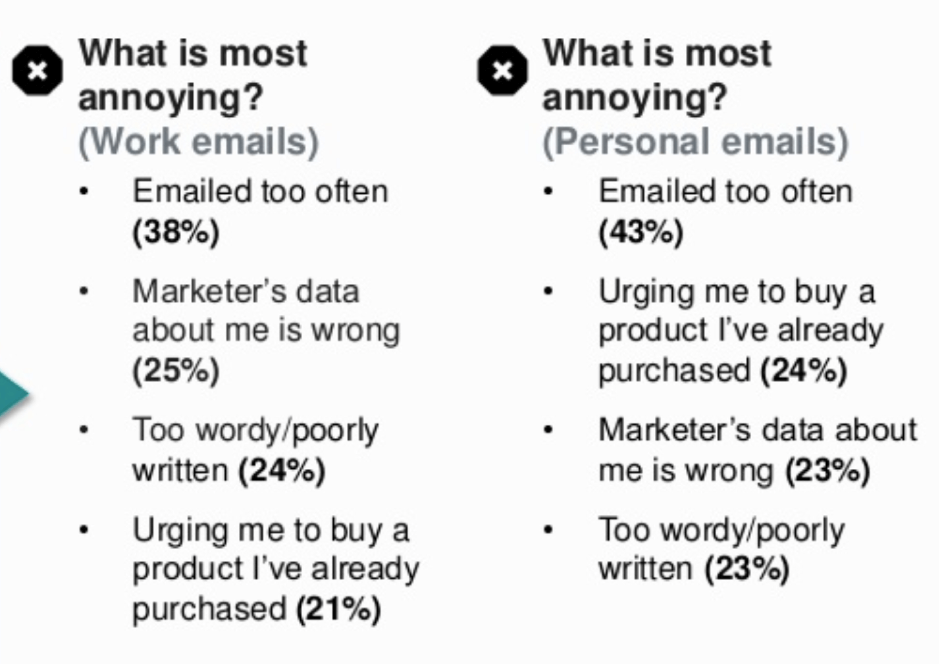
Just under a quarter of recipients of both types of email (24% work email and 23% personal email) say that a big problem is that brand offer emails are either too wordy or poorly written.
As earlier results show, many people are checking emails while out and about or while performing other tasks, suggesting they are reading them on smart devices. Emails that are too wordy are unlikely to display well on these devices and will be skipped or deleted. In terms of poorly written emails, they can make the point of the email unclear while mistakes also increase the chances of deletion, as well as affect trust in that brand and its future emails.
Personalization is an important factor
In terms of things that email marketers are doing right, personalization is right up there. Personalization is most important to Millennials and to B2C recipients. However, it is seen as important for all generations and across both work and personal emails.
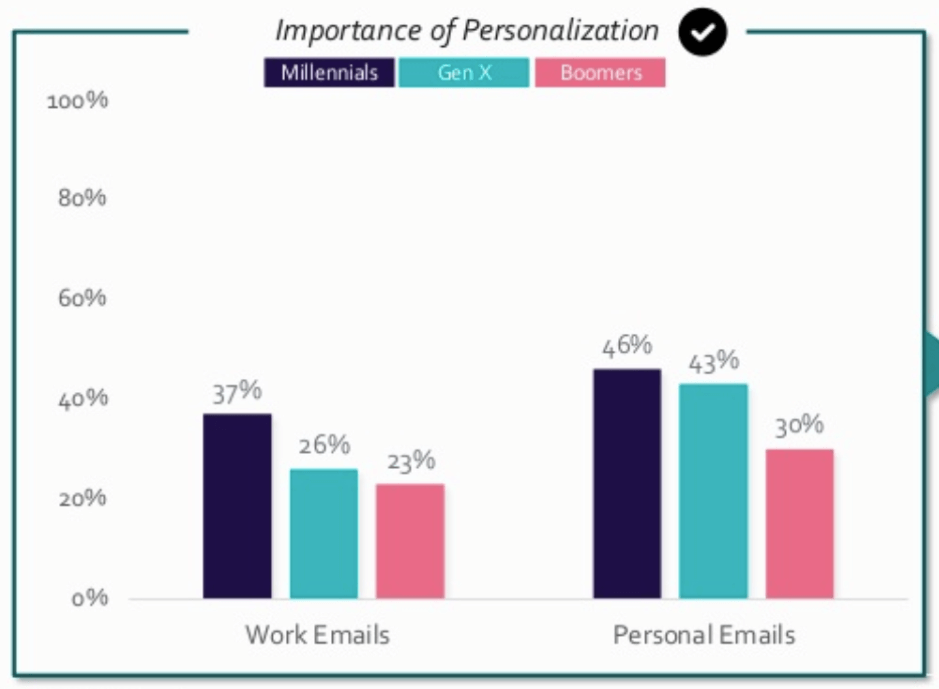
While personalization is a big plus for consumers, many brands are failing to get it right, which is resulting in frustration for email recipients. The biggest problem for both work and personal emails is that the recommendations provided don’t match the recipient’s interests (33% work email and 31% personal email).
19% of both work and personal email recipients also get frustrated when personalized emails misspell their name, with a further 19% of both email types getting annoyed by receiving expired offers.
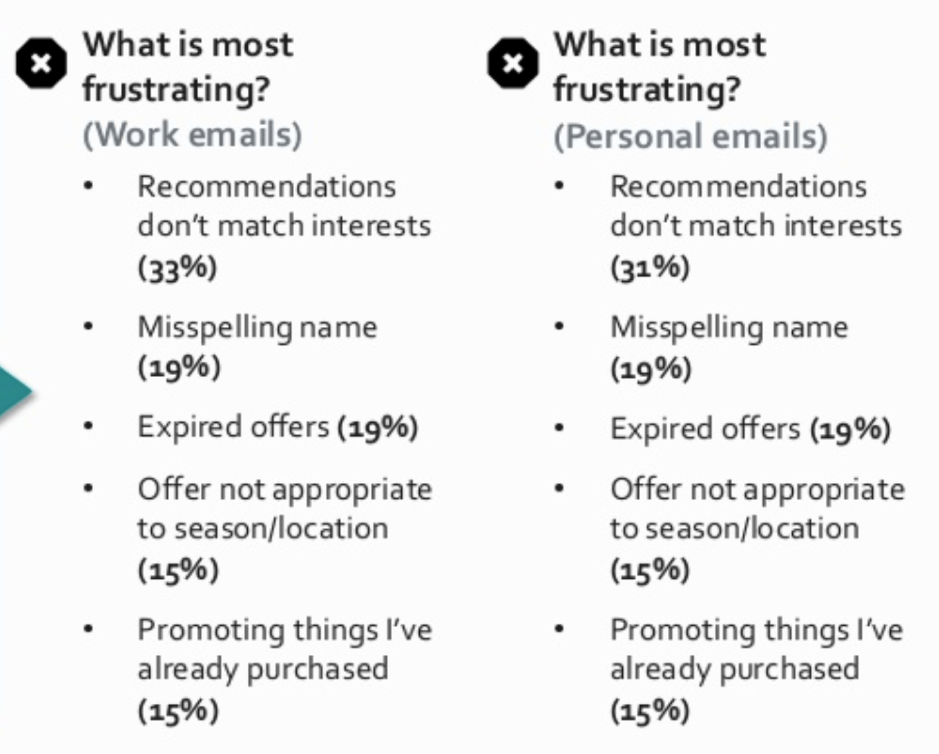
Other frustrations when it comes to email personalization include the offer not being appropriate for the season of location (15% of both work and personal email recipients) and receiving promotions for items that have already been purchased (15% of both work and personal email recipients).
Key takeaways
Getting your emails noticed and read is becoming increasingly difficult, especially in a B2C environment. Crowded inboxes have not only resulted in fewer emails being read and viewed as important but also a decline in the amount of time people are spending reading emails. Email marketers, therefore, need to focus on targeting and email quality in order to stand out for the right reasons.
Smart devices mean that people are more likely to check their emails on-the-go or while performing other tasks. This means that mobile optimization is more important than ever and marketers should adopt a mobile-first approach, as well as reassess the length of their emails.
Personalization is only going to increase in importance and email recipients are more likely to engage with messages that offer a personalized experience. However, getting personalization wrong can have as big an adverse effect as poor quality emails. Ensuring your personalization is correct and well-targeted will ensure better results.
To make sure you’re ready to tackle your email marketing strategy in the next year, make sure you take a look at our article covering the big email marketing trends for 2020. Taking you through what you can expect to become important in the industry over the next 12 months, the blog could help make sure you’re ready to meet customers’ expectations and avoid adding to their frustrations.

















